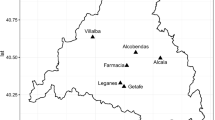Abstract
In this paper, we approach the problem of predicting the concentrations of Poaceae pollen which define the main pollination season in the city of Madrid. A classification-based approach, based on a computational intelligence model (random forests), is applied to forecast the dates in which risk concentration levels are to be observed. Unlike previous works, the proposal extends the range of forecasting horizons up to 6 months ahead. Furthermore, the proposed model allows to determine the most influential factors for each horizon, making no assumptions about the significance of the weather features. The performace of the proposed model proves it as a successful tool for allergy patients in preventing and minimizing the exposure to risky pollen concentrations and for researchers to gain a deeper insight on the factors driving the pollination season.



Similar content being viewed by others
References
Aguilera F, Fornaciari M, Ruíz-Valenzuela L, Galán C, Msallem M, Dhiab A, la Guardia CD, del Mar Trigo M, nd F Orlandi TB (2014) Phenological models to predict the main flowering phases of olive (Olea europaea l.) along a latitudinal and longitudinal gradient across the Mediterranean region. Int J Bioeteorology 59:629–641
Andersen TB (1991) A model to predict the beginning of the pollen season. Grana 30:269–275
Aznarte JL, Benítez Sánchez J M, Lugilde DN, de Linares Fernández C, de la Guardia CD, Sánchez F A (2007) Forecasting airborne pollen concentration time series with neural and neuro-fuzzy models. Expert Syst Appl 32(4):1218–1225
Breiman L (2001) Random forest. Mach Learn 45:5–32
Breiman L (2002) Manual on seeting up, using and understanding random forest. Stat Dept University of California Berkley v3.1
Brighetti MA, Costa C, Menesatti P, Antonucci F, Tripodi S, Travaglini A (2013) Multivariate statistical forecasting modeling to predict Poaceae pollen critical concentrations by meteoclimatic data. Aerobiologia 30:25–33
Cannell M, Smith R (1983) Thermal time, chill days and prediction of budburst in Picea sitchensis. J Appl Ecol 20:269–275
Castellano-Méndez M, Aira MJ, Iglesias I, Jato V, González-Manteiga W (2005) Artificial neural networks as a useful tool to predict the risk level of Betula pollen in the air. Int J Biometeorology 49:310–316
Fawcett M (2003) Roc graphs: Notes and practical considerations for data mining researchers. Tech rep, HP Laboratories
Feher Z, Jarai-Komlodi M (1997) An examination of the main characteristics of the pollen seasons in Budapest, Hungary (1991-1996). Grana 36:169–174
Galán C, Emberlin J, Domínguez E, Bryant RH, Villamandos F (1995) A comparative analysis of daily variations in the Gramineae pollen counts at Cordoba, Spain and London, UK. Grana 34:189–198
Green BJ, Dettman M, Yli-Panula E, Rutherford S, Simpson R (2004) Atmospheric Poaceae pollen frequencies and associations with meteorological parameters in Brisbane, Australia: a 5 year record, 1994–1999. Int J Biometeorology 40:172–178
Jato V, Rodríguez-Rajo F J, Alcázar P, Nuntiis PD, Galán C, Mandrioli P (2006) May the definition of pollen season influence aerobiological results? Aerobiologia 22:13–25
Myszkowska D (2014) Predicting tree pollen season start dates using thermal conditions. Aerobiologia 30:307–321
Nilsson S, Persson S (1981) Tree pollen spectra in the Stockholm region (Sweden), 1973–1980. Grana 20:179–182
Nowosad J (2016) Spatiotemporal models for predicting high pollen concentration level of Corylus, Alnus and Betula. Int J Biometeorology 60:843–855
Palacios IS, Molina RT, Rodríguez A F M (2000) Influence of wind direction on pollen concentration in the atmosphere. Int J Biometeorology 44:128–133
Pauling A, Gehrig R, Clot B (2014) Toward optimized temperature sum parametrizations for forecasting the start of the pollen season. Aerobiologia 30:45–57
Peternel R, Srnec L, Culig J, Hrga I, Hercog P (2005) Poaceae pollen in the atmosphere of Zagreb (Croatia), 2002–2005. Grana 45:130–136
Rantio-Lehtimäki A, Koivikko A, Kupias R, Mäkinen Y, Pohjola A (1991) Significance of sampling height of airborne particles for aerobiological information. Allergy 46:68–76
Ribeiro H, Cunha M, Abreu I (2007) Definition of main pollen season using logistic model. Ann Agric Environ Med 14:259–264
Rodríguez-Rajo F, Frenguelli G, Jato M (1983) Effect of air temperature on forecasting the start of the Betula pollen season at two contrasting sites in the south of Europe (1995-2001). Int J of Biometeorology 47:117–125
Sánchez-Mesa J, Smith M, Emberlin J, Allitt U, Caulton E, Galán C (2003) Characteristics of grass pollen seasons in areas of southern Spain and the United Kingdom. Aerobiologia 19:243– 250
Smith M, Emberlin J (2006) A 30-day-ahead forecast model for grass pollen in north London, UK. Int J Biometeorology 50:233– 242
de Weger LA, Bergmann KC, Rantio-Lehtimaki A, Dahl A, Buters J, Déchamp C, Belmonte J, Thibaudon M, Cecchi L, Besancenot JP, Galán C, Waisel Y (2013) Impact of Pollen. In: Sofiev M, Bergmann KC (eds) Allergenic Pollen, Springer Netherlands, pp 161–215. doi:10.1007/978-94-007-4881-1_6
Acknowledgments
This work has been partially funded by Ministerio de Economía y Competitividad, Gobierno de España, through a Ramón y Cajal grant (RYC-2012-11984).
The authors would like to thank Patricia Cervigón (Comunidad de Madrid) and Montserrat Gutiérrez Bustillo (Universidad Complutense de Madrid) for his assistance in obtaining the data for this study.
The authors would also like to thank the anonymous reviewers for their useful, constructive, and valuable comments, which greatly improved the original version of the manuscript.
Author information
Authors and Affiliations
Corresponding author
Rights and permissions
About this article
Cite this article
Navares, R., Aznarte, J.L. Predicting the Poaceae pollen season: six month-ahead forecasting and identification of relevant features. Int J Biometeorol 61, 647–656 (2017). https://doi.org/10.1007/s00484-016-1242-8
Received:
Revised:
Accepted:
Published:
Issue Date:
DOI: https://doi.org/10.1007/s00484-016-1242-8




